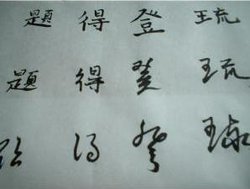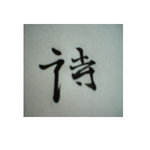Shodo
|
|
Shodō (書道 "the way of writing") is Japanese calligraphy.
Sho.png
Unlike Western-style calligraphy which is written with a pen, shodō is written using a bamboo and animal-hair brush called a fude (筆) on Japanese paper (和紙 washi).
The characters written in shodō are often archaic or Chinese forms. Modern variations or simplifications of characters are rarely used.
| Contents |
Necessary tools
The ink, called sumi (墨), is made from lampblack (soot) and binders, and comes in sticks which must be rubbed with water on an inkstone until the right consistency is achieved. Much cheaper, pre-mixed bottled inks are now available, but these are used primarily for practice as stick inks are considered higher quality and chemical inks are more prone to bleeding over time, making them less suitable for use in hanging scrolls. Learning to rub the ink is an essential part of calligraphy study. Traditionally, Japanese calligraphy is written only in black ink, but modern calligraphers sometimes use other colours. Calligraphy teachers use a bright orange ink with which they write practice characters for students and correct students' work.
A basic shodō kit contains a stone or ceramic inkstone (cheaper inkstones are made of plastic), a selection of brushes, a piece of black felt (shitajiki) which is placed under the writing paper, paper weights and stick or bottled ink. The shitajiki is frequently printed with registration marks in white (usually with four squares on one side and six on the other); these are used as a guide to ensure correct placement and size of the characters. Such printed shitajiki are used only by students. Very long shitajiki are also available; these are used when writing on special long paper.
Study
Smaller pieces of Japanese calligraphy are traditionally written seated in the traditional Japanese way (seiza), on the knees with the buttocks resting on the heels. These days practitioners frequently do shodō seated on a chair at a table. Larger pieces may be written while standing; in this case the paper is usually placed directly on the floor, but some calligraphers use an easel. A paperweight is placed at the top of all but the largest pages to prevent slipping; for smaller pieces the left hand is also placed at the bottom of the page for support. The brush is held in the right hand between the thumb and the index and middle fingers.
Shodō takes many years of dedicated practice. Correct stroke order, proper balance and rhythm of characters are an essential in calligraphy. Skilled handling of the brush produces a pleasing balance of characters on the paper, thick and thin lines, and heavy and light inking.
Works of calligraphy are usually "signed" with the artist's name and stamp, seal or "chop" in red ink.
Styles of shodō
There are three basic styles of shodō, kaisho (楷書, formal or "square" type) gyōsho (行書, "running" or semi-cursive script) and sōsho (草書, "grass script"). Other styles, including tensho (篆書, clerical, or ancient style) and reisho (隷書, ancient style) exist but are rarely practiced in calligraphy (they are, however, still used in hanko).
Kaisho
Kaisho.jpg
Students begin by learning kaisho. This script is the basic style. The character 楷 means "correctness," and each of the strokes in each character written is drawn and placed "correctly," that is, the brush is lifted from the page for each stroke, all the strokes are written distinctly, and the characters appear basically as they would if printed by a word processor (see the example character on the left, meaning "poetry,"). Characters produced are square and angular, with regular spacing.
This style is studied first to give students a feel for correct placement and balance, as well as to provide a proper base for the other, more flowing styles.
Characters written in this style are instantly recognizable.
Gyōsho
Gyōsho is a more cursive script, roughly approximating normal handwriting in which strokes and, more rarely, characters are allowed to run into one another (the example on the left has 13 strokes; in gyōsho style it is written with 8), and characters appear less angular and more round. In writing in gyōsho style the brush leaves the paper less often than in kaisho. The average educated person in China or Japan can read characters written in gyōsho style with relative ease, but may have occasional difficulty.
Sōsho
Sou.jpg
Sōsho is the most cursive script. It is frequently impossible to read characters written in sōsho style without training. Entire characters may be written without lifting the brush from the paper at all (see example, left. This character, meaning "poetry," has thirteen strokes; in sōsho style it is written in 2), and characters frequently flow into one another. Strokes are modified or eliminated completely to facilitate smooth writing and to create a beautiful, abstract appearance. Characters are highly rounded and soft in appearance, with a noticeable lack of angular lines.
See also
External links
- Creating Japanese calligraphy (http://www.japanese-name-translation.com/site/creating_japanese_calligraphy.html)
- Tools used in Japanese calligraphy (http://www.japanese-name-translation.com/site/japanese_calligraphy_tools.html).ar:شودو


